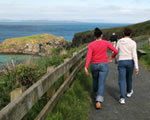 Mynd i'r prif gynnwys
Mynd i'r prif gynnwys
Gwefan llywodraeth y DU
Nodwch fod gan y wefan hon system allweddumynediad llywodraeth y DU
Trefn llywio pennaf
dolenni i dudalennau eraill yn yr adran hon
Yr amgylchedd a byw'n wyrdd - Nodwch, os gwelwch yn dda, na ddiweddarir yr adran hon bellach

Discovering the UK's coastline

The UK coastline is over 11,000 miles long. It is home to many species of wildlife, on land and at sea. Find out how you can enjoy exploring different parts of the coast, and help conserve the landscape and the wildlife for future generations to enjoy.
Exploring the coastline
The UK coastline is spectacular and varied, and a popular destination for visitors. They come to explore the beaches, walk cliff top trails, see wildlife and visit the seaside towns. There are about 1,827 miles of accessible coastline in England alone.
Many more stretches of coastline will become accessible under the Marine and Coastal Access Act 2009. This will create a footpath round the entire length of the open coast of England, together with areas where people can explore, rest or picnic.
It will take about 10 years to complete the footpath. You can find more details of these plans, and of the Marine and Coastal Access Act 2009, on the Natural England website.
Types of coastal areas
There are many different types of coastal areas in the UK. Some are special because of the landscape, and lie in an Area of Outstanding Natural Beauty or in a National Park. Many of these are also protected as Heritage Coasts.
Others are home to important and varied wildlife, and are managed as Sites of Special Scientific Interest and Marine Protected Areas.
Heritage Coasts
Heritage Coasts represent stretches of undeveloped coastline, both on land and at sea. These are managed to conserve their natural beauty and, where possible, to improve accessibility for visitors.
Many stretches are easily accessible by a network of public footpaths and bridleways, some of which are classed as National Trails. Over 650 miles of scenic English coastline is conserved as Heritage Coasts and some examples include:
- the dramatic white chalk cliffs at Beachy Head in Sussex
- the sheer cliffs and seabird colonies at Flamborough Head and Bempton
- the ever-changing coastline of Suffolk with its reed-fringed creeks, tidal marsh and low heath-backed cliffs
You can easily explore many stretches of these beautiful areas via a network of public footpaths and bridleways. You can find details of Heritage Coasts on the Natural England website.
Marine Protected Areas
Marine Protected Areas (MPAs) are areas in the seas and around the coast that are important for marine wildlife and are protected from damaging human activity. MPAs allow the animals and plants living there to thrive undisturbed. They also create a place for people to learn about marine life, and enjoy and study the natural environment.
There are different types of MPAs to protect marine animals and undersea landscapes. To find out more about the different habitats you can visit, and where they are, visit the Natural England website.
Nature and wildlife
Britain's coastline is home to a huge variety of wildlife, from bottlenose dolphins and basking sharks to corals and clams. The sea-cliffs and craggy coastal rocks also make ideal nesting sites for gulls and other seabirds. You should also look out for:
- wading birds along the shoreline
- inter-tidal marine life, like crabs, limpets, spectacular seaweeds and small fish, in rock pools
- starfish, jellyfish and burrowing shells on beaches
- seals close to shore
More information on birds can be found on the Royal Society for the Protection of Birds (RSPB) website, and details of other coastal wildlife is available from the Wildlife Trust. More information on marine life is available from the Marine Life Information Network website.
Respect, protect and enjoy the coastal environment
The UK coastline is important to people and wildlife alike. It is a natural resource to be enjoyed and conserved.
Help keep the coast clean and safe for other visitors, and for the plants and animals who depend on it for their survival. The Countryside Code gives you advice on how to do this. Some key tips are:
- be safe, plan ahead, and follow signs and waymarks
- let others know where you are going and when you expect to return
- protect plants and animals and take your litter home with you
- rock pools are home to many species so treat them with care
- keep dogs under close control, and clean up after your pet
- leave gates and property as you find them
Consider other people, especially when driving through narrow coastal lanes, or maybe travel by bike or public transport instead.
When you are at the coast, it also makes sense to:
- only swim in areas that are safe for bathers
- keep bathing water clean by using public toilets instead of the sea
- check the times of the high tides to make sure you are not left stranded by rising waters
You can find more information about safe swimming in the sea and lifeguards in the articles on 'Lifeguards and safety flags' and 'Understanding waves, tides and currents'
For more details of the Countryside Code, visit the Natural England website.
 Facebook
Facebook Twitter
Twitter StumbleUpon
StumbleUpon Delicious
Delicious Reddit
Reddit